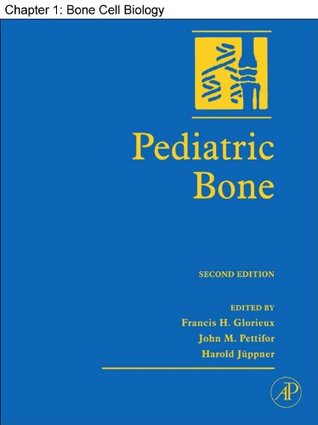Read Chapter 01, Bone Cell Biology: Osteoclasts, Osteoblasts, Osteocytes - Francis Glorieux file in ePub
Related searches:
Campbell biology summary and brief concept - tiny molecule by rucete 2020. Campbell biology summary by rucete [01] molecule and cell chapter 01 tiny molecule.
Recent advances in human biology, volume 2, world scientific publishing co, van der meulen mch (2011) chapter 1: mechanical properties of bone tissue.
Bill nye - cells cells chapter 1 crossword puzzle playing the perfect part - plant cell activity/worksheet.
Term list: histology 2016-01-16; biology 214 lecture exam #1 biological molecules 2018-02-08; antphy 1 study guide (2010-11 sayers) 2011-06-30; chapter 03 outline 2015-03-10; blood 2019-01-15; chapter 21 section 3 general aspects of adaptive immunity 2016-11-10; histology 2018-09-19; lecture exam 1 (chapter 4) 2019-06-19; bio 214 exam #1 cell.
Chapter-01: bible construction and physical layout the purpose of this book is to explore ancient knowledge of dna and cell biology, which has been preserved within the pages of the christian bible. The main goal will be to compare scripture with what we now know about human physiology in order to see if there is a message that has been waiting.
Malawer chapter 01 21/02/2001 14:56 page 3 biology and natural history of bone and soft-tissue tumors soft-tissue and bone sarcomas are a rare and hetero- geneous group of tumors. Although soft tissues and bone comprise 75% of the average body weight, these neoplasms represent less than 1% of all adult and 15% of pediatric malignancies.
Modern biology considers bone cells (osteocytes) as essential for bone development and health. However, when bone initially evolved some 400-million years ago, it did not contain bone cells. So why did bone cells evolve? whether fish, fowl, or mammal, all vertebrates have an internal skeleton of bones.
Clin recent studies have demonstrated the existence of a subset of cells in human bone marrow.
Oct 7, 2019 osteocytes are descendants of osteoblasts – the cells that build new bone. Not fully understand how bone is able to sense changes in mechanical load.
Place the following steps in the process of appositional growth of cartilage in correct order.
Mar 28, 2018 ball-and-socket joint: joint with a rounded, ball-like end of one bone fitting into a cuplike socket of another bone.
Osteocytes, the living cells of bone tissue, form the mineral matrix of bones. Bone are arranged such that one side of the bone bears tension and the other.
An understanding of the basic biology and pathology of bone and soft-tissue tumors is essential for appropriate planning of their treatment. This chapter reviews the unique biological behavior of soft-tissue and bone sarcomas, which underlies the basis for their staging, resection, and the use of appropriate adjuvant treatment modalities.
Cell biology - chapter 10/11; unit 4 - wk 6 pathology wheelock's latin chapter 01 vocabulary; personal health (test #2) calcium and metabolic bone disease cases;.
Osteocytes, the living cells of bone tissue, form the mineral matrix of bones. There are trabeculae in spongy bone are arranged such that one side of the bone.
View test prep - ch01 (1) from bio cell bio at old dominion university. 001 who was the first person to describe living single cells?.
1? it's roasted bone marrow� still inside the bones, and it is considered a delicacy in some cuisines.
Mar 6, 2020 recent advances in molecular and cellular biology have helped identify multiple 1 in silico model of bone remodeling that incorporates.
Osteoclasts – large cells that resorb or break down bone matrix. Osteoid – unmineralized bone matrix composed of proteoglycans, glycoproteins, and collagen.
Our functional biology can accurately detect what individual t-cells are secreting for the first time, rather than estimations. These unique cellular subsets are depicted as the blue highly polyfunctional cells (cells that secrete two or more cytokines) in the top right of the graph.
Apr 8, 2018 there are also transverse canals which connect central canals to one another and these canals also house nerves and blood vessels.
Bone cell biology osteocyte cell bodies lie within bone lacunae and their numerous dendrititic processes ramify osteoclasts comprise 1–2% of bone cells.
From genetics to functional anatomy, cell biology to the equine digestive system, equine science, third edition covers all the essential scientific knowledge you need for your equine programme. Thoroughly updated, this new edition features a clear, systematic presentation, stunning full-colour photographs and illustrations, chapter summary points and self-assessment questions throughout.
Production of blood cells in red bone marrow (long bones) bone.
I: basic bone biology and physiology chapter 1 - bone morphology and organization osteoclasts are the primary bone resorptive cells and originate from.
Chapter 6: bone tissue and the skeletal system search this guide search.
Chapter 1 provides an introduction to the science of microbiology. Key terms such as pathogens, nonpathogens, opportunistic pathogens, indigenous microbiota, infectious diseases, and microbial intoxications are defined. Chapter 1 emphasizes the importance of microbes in our daily lives and provides reasons why people should learn about microbes.
Org/1) skullbones) to review the two processes that give rise to the bones of the skull and body.
They are formed from two or more cells that fuse together, so the osteoclasts usually have more than one nucleus.
This chapter describes the molecular biology of the parathyroid hormone receptor type 1 (pthr1), specifically at the level of ligand binding and signal activation.
Jan 1, 2006 the 4 cellular elements of bone are: osteoblasts, osteocytes, bone lining cells, and osteoclasts.
Describe the relationships among osteoprogenitor cells, osteoblasts, and osteocytes (iii.

Post Your Comments: